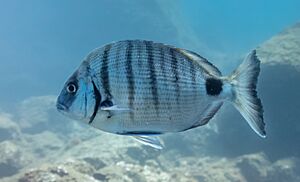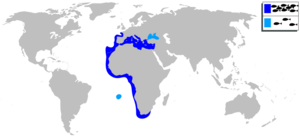Sargo facts for kids
Quick facts for kids Sargo |
|
|---|---|
 |
|
| Conservation status | |
| Scientific classification | |
 |
|
| Range of Diplodus sargus sensu lato | |
| Synonyms | |
|
The Diplodus sargus, also known as the sargo or common white seabream, is a type of fish that lives in the ocean. It belongs to the Sparidae family, which includes other seabreams and porgies. You can find this fish in the eastern Atlantic Ocean and the Mediterranean Sea. People catch the sargo for food, and it's also raised on fish farms. Scientists used to think there was just one widespread type of sargo, but now they know there are several different kinds that look very similar.
Contents
Understanding the Sargo Family Tree
The white seabream was first officially named Sparus sargus by Carl Linnaeus in 1758. He was a famous scientist who created the system we use to name living things. The sargo is closely related to another fish called Diplodus vulgaris. These two fish are part of a group called Diplodus.
Many Types of Sargo
For a long time, scientists thought the sargo was one species found in many places. But now they know there are several distinct species. These include fish like D. noct from the Red Sea and D. capensis from South Africa. All these similar fish form what scientists call the D. sargus species complex. It's like a family of very similar cousins!
Where Sargo Fits In
The Diplodus group of fish belongs to the Sparidae family. This family is part of a larger group called Spariformes. Scientists use these groups to organize and understand all the different kinds of fish in the world.
What's in a Name? The Sargo's Story
The name sargus comes from the Greek word sargo. This name was used for a type of seabream even as far back as the time of Aristotle. So, the fish has had a similar name for a very long time!
Meet the White Seabream: Appearance and Size
The white seabream has a body that is deep and a bit flat from side to side. Its back is high and curved. Its cheeks and gill cover (the bony flap protecting the gills) are covered in scales.
Sargo's Mouth and Teeth
The sargo has a mouth at the very front of its head with thin lips. It can push its jaws out slightly. At the front of each jaw, it has 8 to 10 teeth that look like incisors (the flat teeth we use for biting). Behind these, it has several rows of teeth that look like molars (flat teeth for grinding).
Fins and Colors
The sargo's dorsal fin (on its back) has 11 or 12 sharp spines and 12 to 16 soft rays. Its anal fin (on its belly) has 3 spines and 12 to 14 soft rays. The caudal fin (tail fin) is forked, like a "V" shape.
The fish is mostly silvery-grey. The front of its head is darker. It has 9 vertical stripes on its body. These stripes can be very dark and light, or sometimes just dark. There's a dark, saddle-shaped spot near its tail, right behind the dorsal fin. You'll also see a black spot above its pectoral fin (the fin on its side, like an arm). The dorsal and anal fins are dark, getting even darker at their edges. The very back edge of the tail fin is black. Young sargos only have 5 stripes.
How Big Do They Get?
The white seabream can grow up to about 45 centimeters (about 18 inches) long. However, they are usually around 22 centimeters (about 9 inches) long. The heaviest sargo ever recorded weighed about 1.9 kilograms (about 4.2 pounds).
Where the Sargo Lives: Home and Habitat
You can find Diplodus sargus in the northeastern Atlantic Ocean. This includes areas from southern Brittany in France, the Bay of Biscay, and the coasts of Spain and Portugal. They also live throughout the Strait of Gibraltar, the Mediterranean Sea, and the Black Sea. Recently, they have been moving further north and have even been seen near the Channel Islands.
Favorite Places to Live
The white seabream is a benthopelagic fish. This means it lives near the bottom of the ocean but can also swim in the open water. They often swim in schools (large groups) along coastlines. They like rocky areas mixed with sand. You'll find them from the surface down to about 150 meters (about 490 feet) deep. They are most common in the surf zone, where waves break. Young sargos often live in beds of Zostera (a type of seagrass). They also use estuaries (where rivers meet the sea) as safe places to grow up.
Sargo's Daily Life: What They Eat and How They Behave
Diplodus sargus is active during the daytime. It's an omnivore, meaning it eats both plants and animals. Its diet includes algae, sea-urchins, worms, snails, and small crustaceans called amphipods.
A Helping Hand in the Ocean
Interestingly, white seabream have been seen acting as "cleaner fish." This means they help other fish by eating parasites off their bodies. They've been observed cleaning mullets like the Thicklip grey mullet and the Flathead grey mullet.
Reproduction and Life Cycle
In places like the Gulf of Tunis, white seabream lay their eggs (this is called spawning) from March to May. This happens when the water temperature rises from about 15°C to 18°C (59°F to 64°F). Their reproductive organs become active after the colder winter months. In warmer areas closer to the equator, the spawning season lasts longer.
Sargo and People: Fishing and Farming
The Diplodus sargus is a popular fish for commercial fishing. In 2008, about 3,713 tonnes of sargo were caught. Most of these fish are caught by small-scale fishers using fish traps, gill nets, and handlines. They can also be caught by accident as bycatch in shrimp trawls.
Farming Sargo
People have tried to raise white seabream on fish farms in the Mediterranean. This is called aquaculture. However, it has been a bit difficult. The sargo grows slowly after its first year, which makes it less profitable for large-scale farming.
A Mystery of Tough Fish
Since the 1990s, some cooked white seabream have been found to be unusually tough and hard to eat. This problem is not related to how fresh the fish is. Scientists call this the "abnormally tough specimen" (ATS) phenomenon. The exact cause is unknown, but it seems to happen in areas with pollution, especially from things like copper found in paints used on boats.
Famous Namesakes: Sargo in History
The common name "sargo" is used for this fish in many languages. It's also used for other food and game fish in the porgy family, especially in the coastal waters of the southern United States. An example is the sheepshead fish (Archosargus probatocephalus).
Two submarines in the US Navy were named after this quick and agile fish: USS Sargo (SS-188) and USS Sargo (SSN-583).


